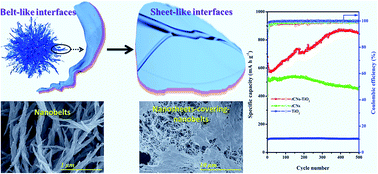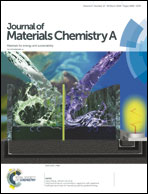Oil/molten salt interfacial synthesis of hybrid thin carbon nanostructures and their composites†
Abstract
Hybrid thin carbon nanostructures (tCNs) and tCN-based composites are important in energy and environmental applications, but their effective synthesis remains a great challenge. In this study, we developed a novel strategy – interfacial synthesis – to produce tCNs which takes advantage of the immiscible nature of hydrophobic oily substances (C source) in hydrophilic molten salts (catalyst) to confine the anisotropic growth of tCNs solely at the liquid (oil)/liquid (molten ZnCl2) interfaces. Typically, the interfaces in a heated and highly dynamic system induced the formation of tCNs with a hybrid morphology in which nanosheets covered nanobelts. Moreover, tCN-based nanocomposites were easily fabricated by adding specific nanoparticles into the hydrophilic/hydrophobic mixture. The tCN products exhibit superior application potential; as an example, the tCNs and tCNs–TiO2 nanocomposites showed outstanding performance as anode materials in a lithium ion battery with a capacity of 858.7 mA h g−1 after 500 cycles at 500 mA g−1. In addition to the model oily substances, waste oil can also be used as the precursor for the synthesis of tCNs. It is anticipated that interfacial synthesis not only enables broad and controllable synthesis of high-quality tCN-based nanomaterials, but also provides an effective environmental solution to transform waste hydrophobic liquids into high value-added carbon materials.



 Please wait while we load your content...
Please wait while we load your content...